Eddie A Mandarin Duck on the Lam
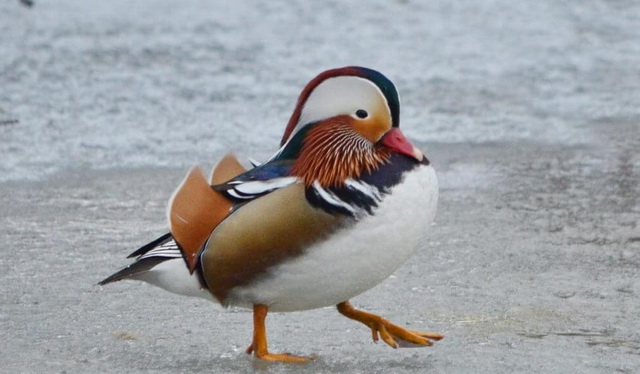
Mandarin Ducks breed in Eastern Siberia as far south as North Korea, and they winter by choice in southern China and Japan. So, when a Mandarin Duck like Eddie shows up in a small town in Ontario, Canada, it creates a lot of excitement.
Bob and I first started seeing photos of a gorgeous male Mandarin Duck posted to various social media pages in late December. The duck had showed up in Newmarket about 30 minutes north of where we live in Toronto, Ontario.
Bob and I were reluctant to venture that far from home because of the coronavirus-19 pandemic. Current guidelines did not forbid it, but we were making every effort to keep clear of other people.
As information gradually found its way to us, we learned that the Mandarin Duck named Eddie had escaped from a local farm owned by Tracey Harpley.
Tracey is a dedicated person who takes in small domestic and wild animals that are injured or have been abandoned. As a licensed wildlife foster person, Tracey works to rehabilitate them.
Eddie landed up at Tracey’s farm as a kindness to her young daughter who is not allowed to handle the wildlife. Tracey had gone to a breeder to pick up an injured day-old duck, and while there, Tracey’s daughter requested to be allowed to take a duck home, too. Eddie was the chosen one.
It is so wonderful that Tracey allows her rescued ducks to be flighted. They have the freedom of a large pond on her farm, but if a predator threatens, they can fly to escape or simply return to the pens for the night.
Under normal circumstances, Tracey keeps her rescued ducks off the pond for several weeks during fall migration so that they do not mingle with the flocks of Canada Geese, Mallards and Swans that inevitably stop by.
In mid-December, given the extremely mild winter in Ontario, Tracey was caught off guard when a flock of 300 Canada Geese flew in. Tracey’s ducks joined the melee, and before you know it, something spooked the whole lot. All of Tracey’s rescues returned to their pens except for Eddie. He was off for an adventure.
Several ponds remained unfrozen in the vicinity of Tracey’s farm, and after Eddie’s escape, he had been spotted a few times. He was seen quite regularly with about 100 Mallard Ducks at Fairy Lake in Newmarket .
Tracey and other people concerned for Eddie were well aware of his location, and repeated attempts were made to capture him. Tracey’s daughter was really missing Eddie because he usually followed her around like a dog.
After seeing one-year-old Eddie, a few observers were quick to share their excitement, and photos began popping up on Facebook. Who could resist snapping a few of this most beautiful and exotic duck?
The photographs caught the eye of many bird watchers who jumped at the chance to see a Mandarin Duck in the wild even if it was an escapee. The town of Newmarket became the centre of attention for twitchers who descended to the location of Fairy Lake Park to catch a glimpse of Eddie.
While photographers lined the snow-packed bank of the river hoping to capture Eddie’s saucy behaviour towards the Mallards, Tracey worked at enticing Eddie into a pen.
Eddie was familiar with the routine. Food had been placed into the pen, and there were a couple of occasions where Eddie was nearly caught. Over-eager photographers inadvertently alarmed Eddie who was quick enough to dart away.
For 2 weeks, Bob and I resisted the temptation to go for a look at Eddie. Finally we made the trip to Newmarket only to find that Eddie had flown off about 40 minutes before we got there.
As a consolation, we photographed the female Mandarin Duck that had mysteriously shown up at the same location about a week before.
Experts believe that the female Mandarin Duck was released by one of Eddie’s admirers to encourage him to remain at the river instead of returning home.
A female Mandarin Duck bears a close resemblance to the female of our native Wood Ducks.
In fact, for a whole week, many people thought that the female Mandarin Duck was a female Wood Duck.
It is no surprise to learn that the two species are closely related. They are the only 2 species belonging to the same genus, Aix.
On the overcast afternoon when we were there, the subtle beauty of the female’s plumage was not so easily appreciated.
Bob and I lingered at the edge of the river waiting to see if Eddie would return. Alas, it was after leaving, we learned that Eddie had been rediscovered at a different location.
A friend advised us that a concerted effort to recapture Eddie would be made in 2 days time with the help of the Toronto Wildlife Centre. Bob and I decided to try once again early the following morning.
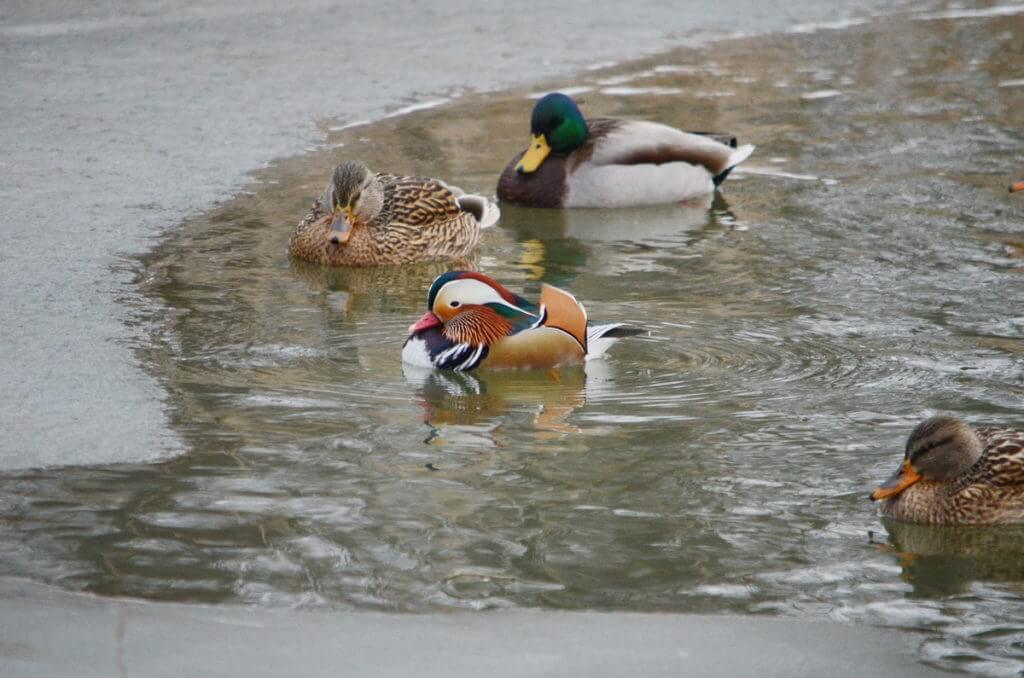 We found Eddie paddling effortlessly at the edge of the ice.
We found Eddie paddling effortlessly at the edge of the ice.
At that early hour, only a handful of other photographers were there to appreciate Eddie’s radiance with one daring enough to lay prone on the thin veneer of frozen water. Bob and I made a point to practice “Social Distancing” and wore face masks even as we stood on the opposite side of the river by ourselves.
A short bridge spanning the flowing river provided an overview of the gathered waterfowl. Despite the incredibly vibrant colours of Eddie’s plumage, he wasn’t that easy to pick out. Bright sunshine would have been a big help.
With most of the river frozen over, it left only a small area of open water wherein the ducks congregated.
Like so many others, we were immediately smitten with Eddie. The trait that I first noticed was his full set of “whiskers”. In a vibrant shade of orangey-red, these plumes seemed to be an extension of his orange cheeks. They really endeared Eddie to me.
As Bob and I looked on, Eddie began to bathe and preen his beautiful plumage.
Multiple times, he dipped below the shiny surface then fluttered his wings as he arose from the frigid water.
In shades of purple, blue, orange, green and white, the colours of Eddie’s plumage combine to create an exotic looking duck.
Orange feathers that curl into a “sail” on either side of his back, and bold white crescents above the eyes combine to make Eddie one of the most striking ducks we had ever seen.
We were so happy when Eddie decided to climb out of the water. As the owner indicated, Eddie was not at risk of freezing. She was more concerned for Eddie because his colourful plumage put him at risk of becoming prey for some hawk or human predator.
There on the ice, Eddie appeared to be showing off, but it wasn’t for the female Mandarin Duck because she was nowhere to be seen. Back at Tracey’s farm, Eddie already has a female friend, a Mandarin Duck called Indy.
It is in the winter when male Mandarin Ducks perform their courtship rituals.
As a suitor, a Mandarin Duck will bob its head, shake its body and flash its feathers.
We were duly impressed when Eddie raised his crest and orange “sail” feathers.
The Mallard Ducks paid Eddie no heed.
Bob and I did not remain at the location long because we were also on a mission to see a rare winter visitor to a nearby backyard…a Summer Tanager.
The following morning, our friend notified me that Eddie had been successfully recaptured. Tracey, with the help of 3 off-duty volunteers from the Toronto Wildlife Centre, Sarrah, Maggie and Ann, as well as Animal Control and a community member, Angela, finally managed to net Eddie. Video courtesy of Ann Brokelman.
Our friend, Ann Brokelman, kindly provided this photo of Eddie after he was carefully and quickly put into the cage. Other photographers still clambering to see Eddie fired off shots to capture the moment.
Safely back at his home on the farm, Tracey said that Eddie was happy to see Indy. Eddie is being kept indoors until blood tests confirm that he is free of contagions that might have been picked up while Eddie was on the lam. This photo courtesy of Ann Brokelman.
Tracey has acquired a permit that allows her to capture the dumped female Mandarin Duck but the last we heard, the female was still on the loose. If caught, this duck will have a home at Tracey’s farm, too.
In the ensuing days, the town declared Eddie to be the Honourary Duck of Newmarket for the joy he brought to the town’s residents and the international attention generated by his story. It was a welcome relief during these stressful pandemic times.
Related:
Snowy Owls on Amherst Island in Ontario, Canada
Eastern Screech Owlet in Rouge National Urban Park, Toronto

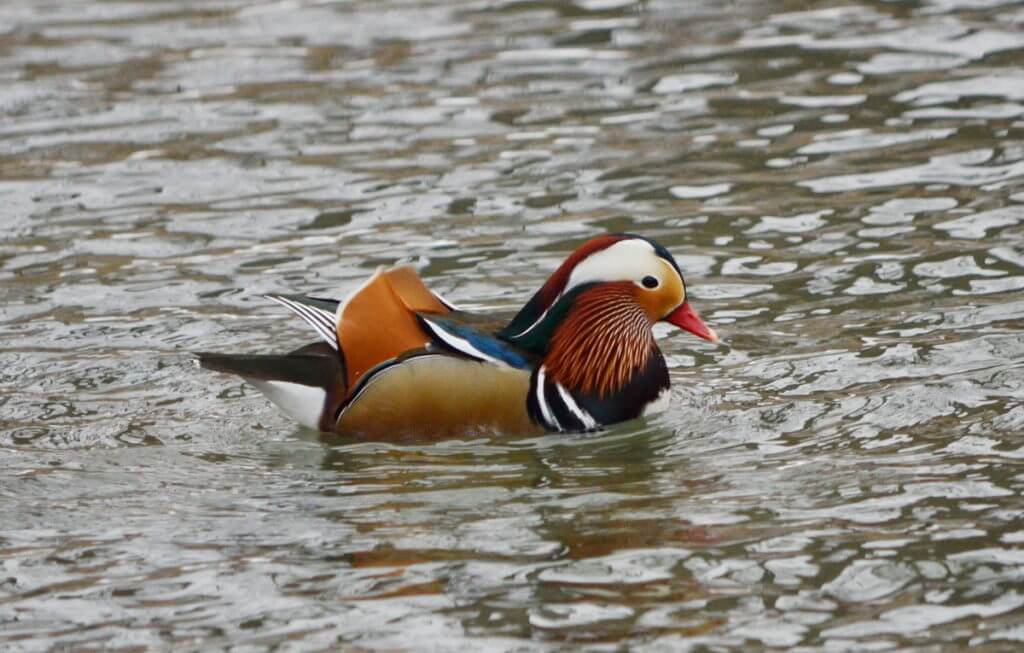

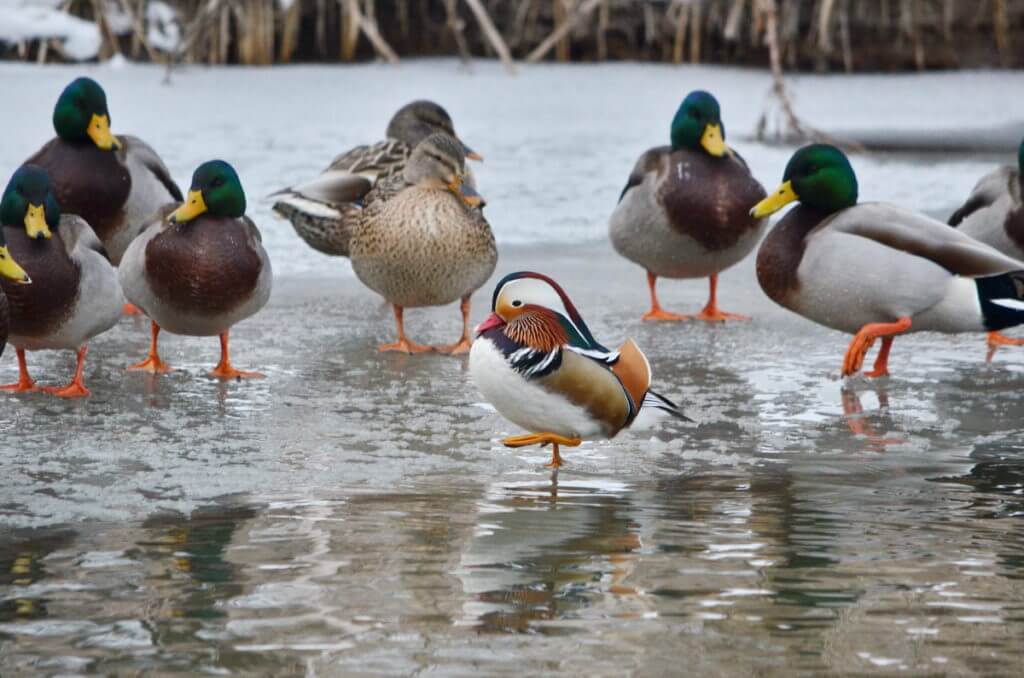

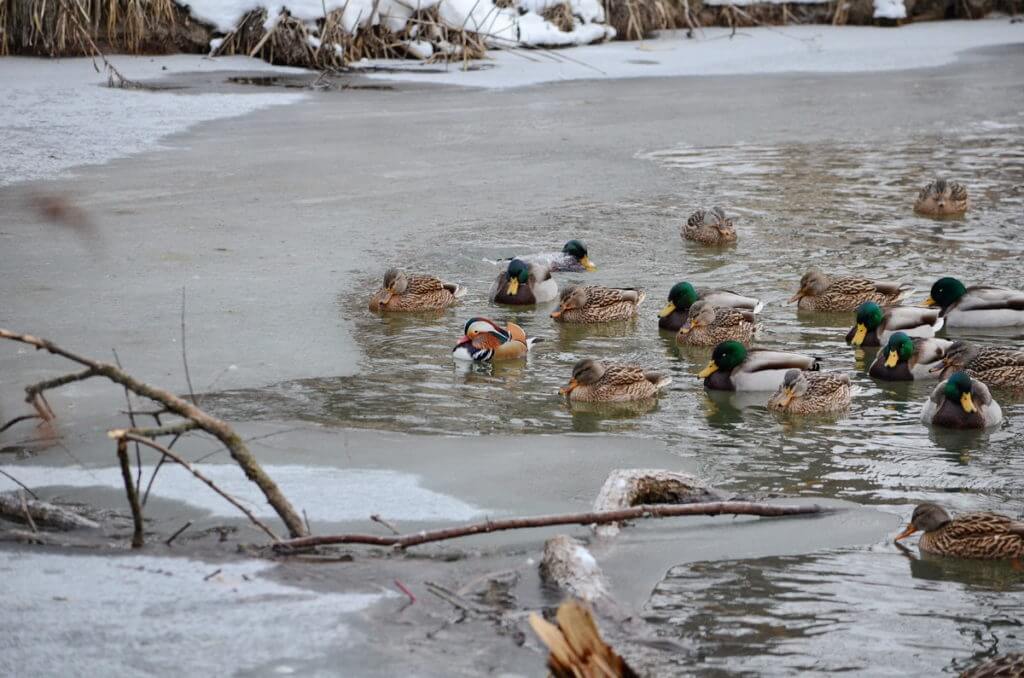

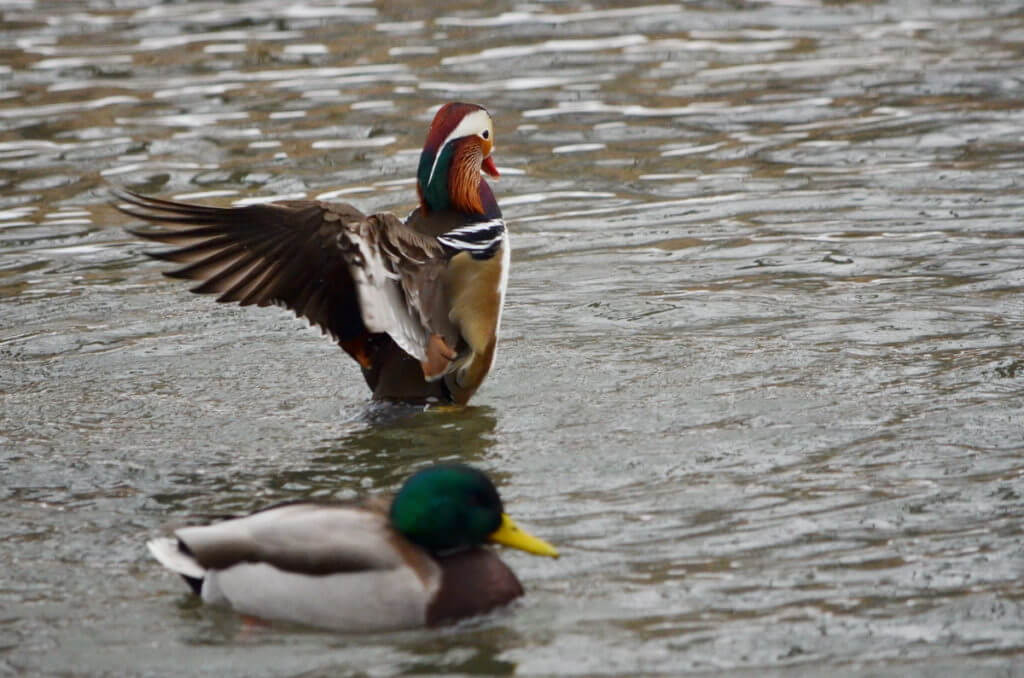
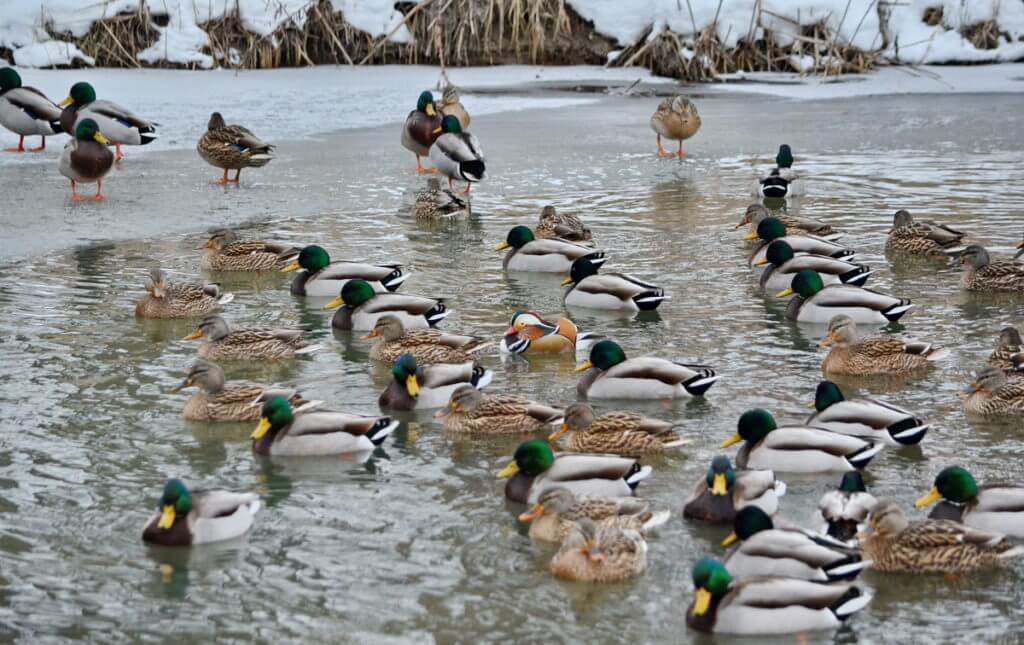
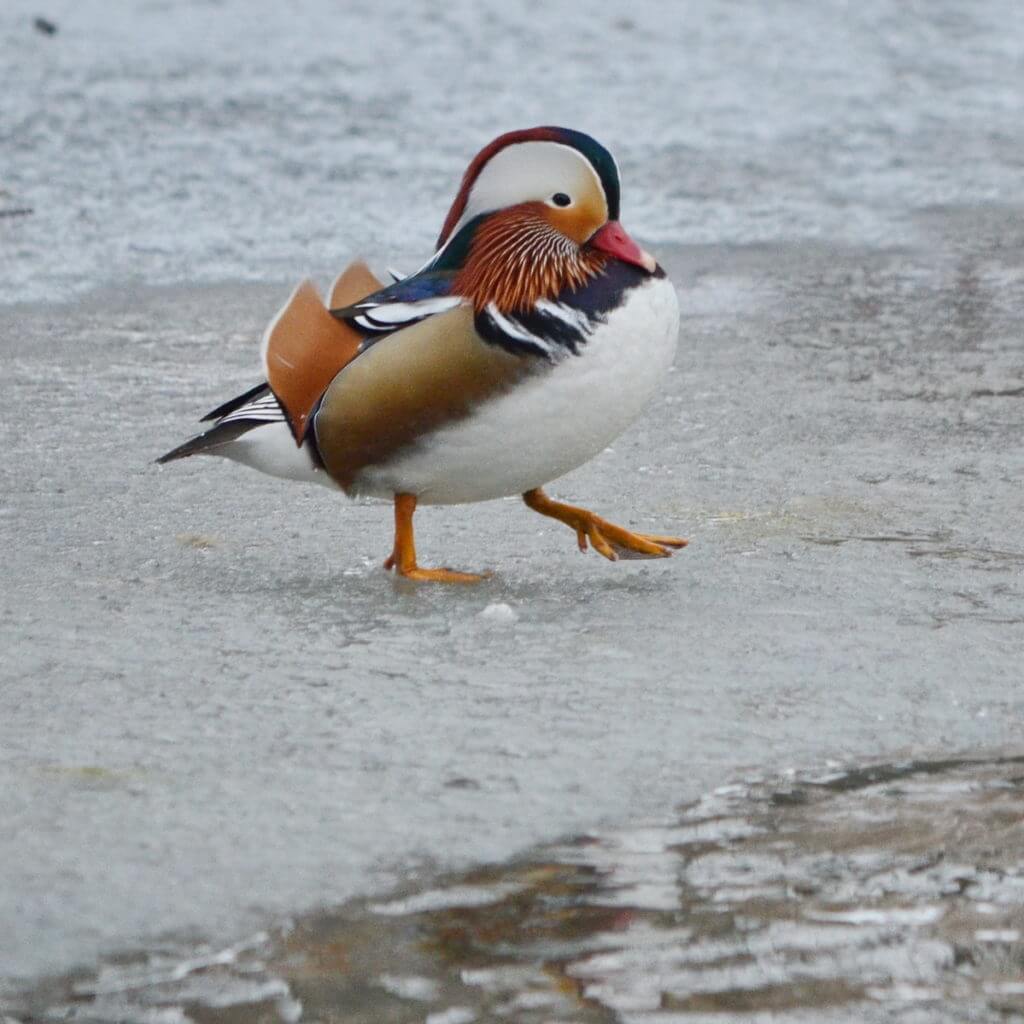
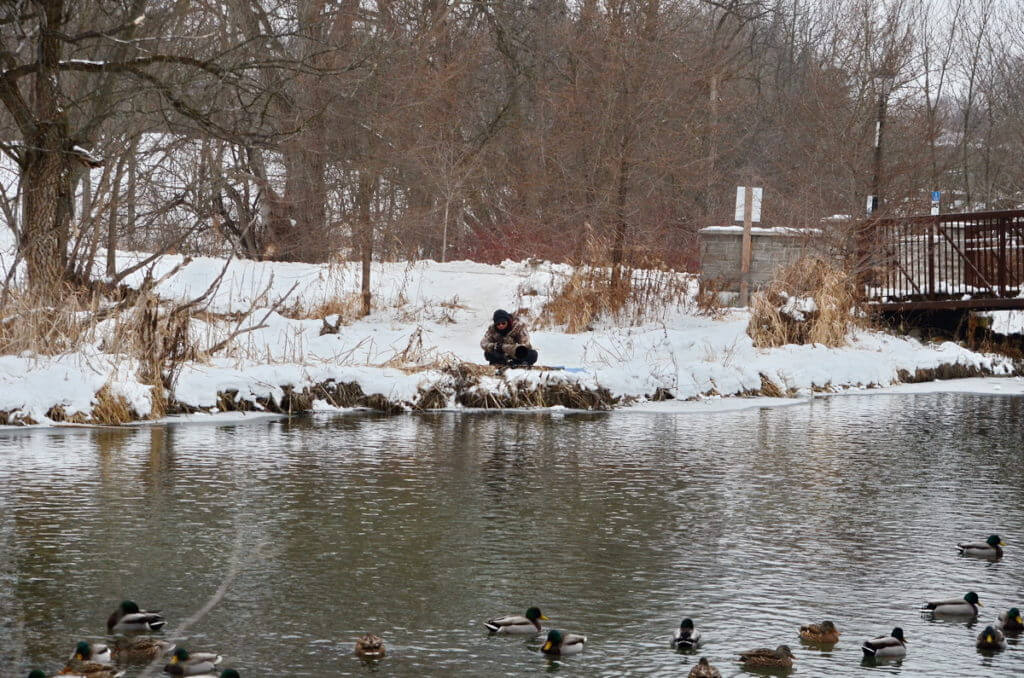
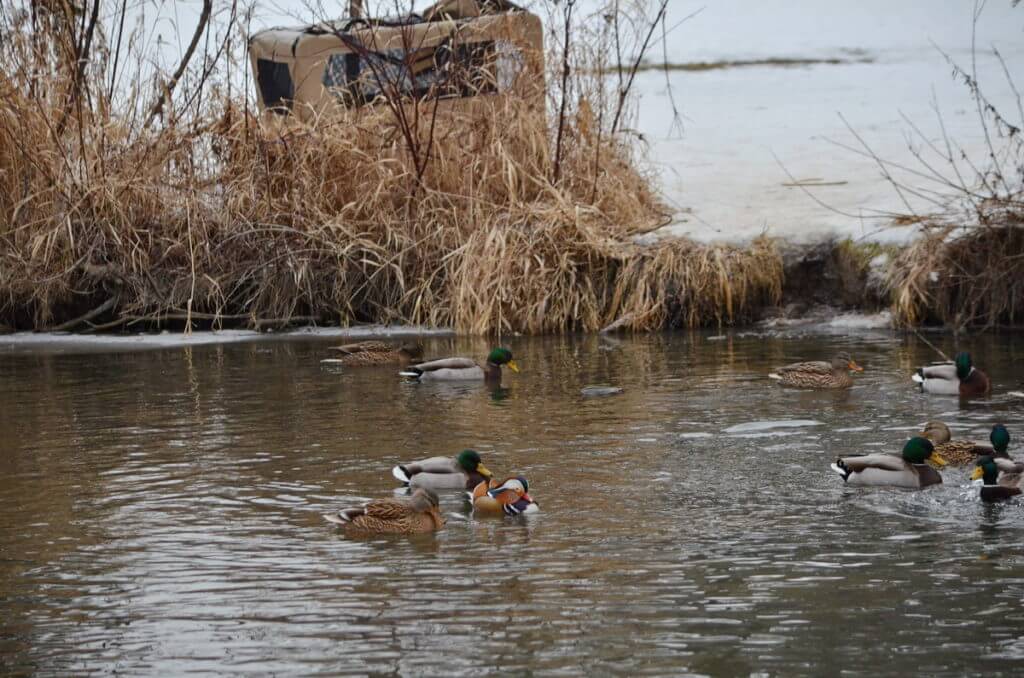

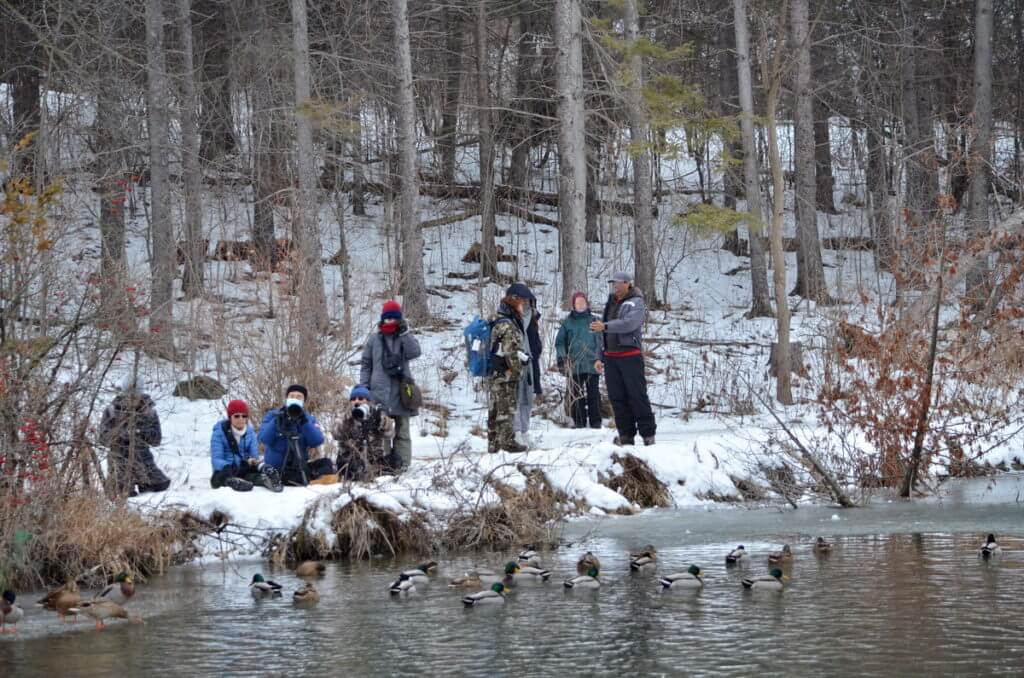



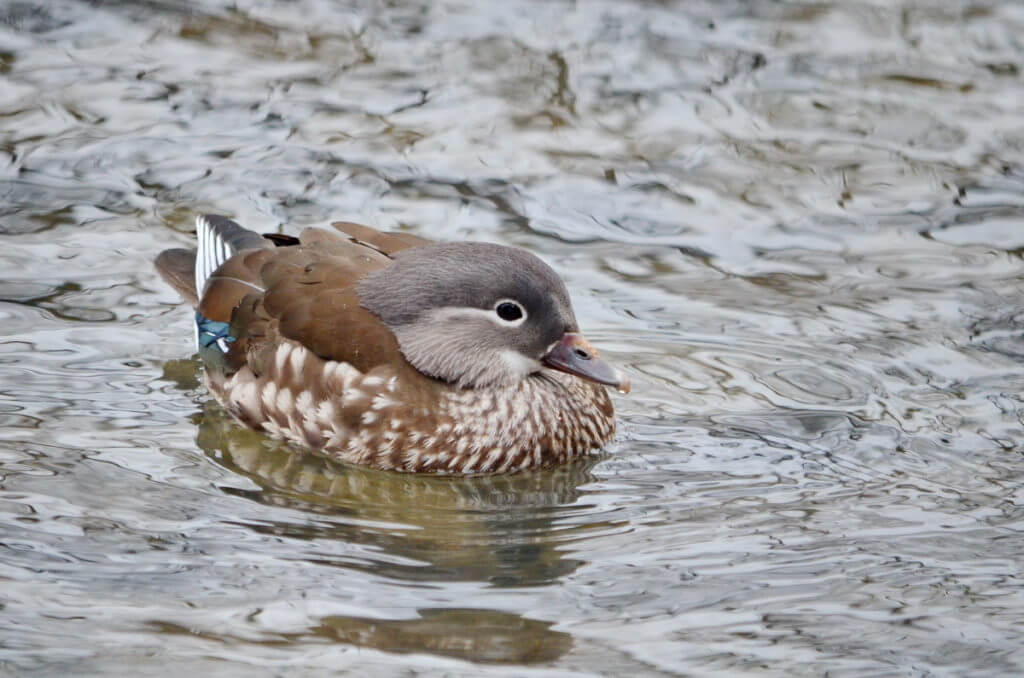
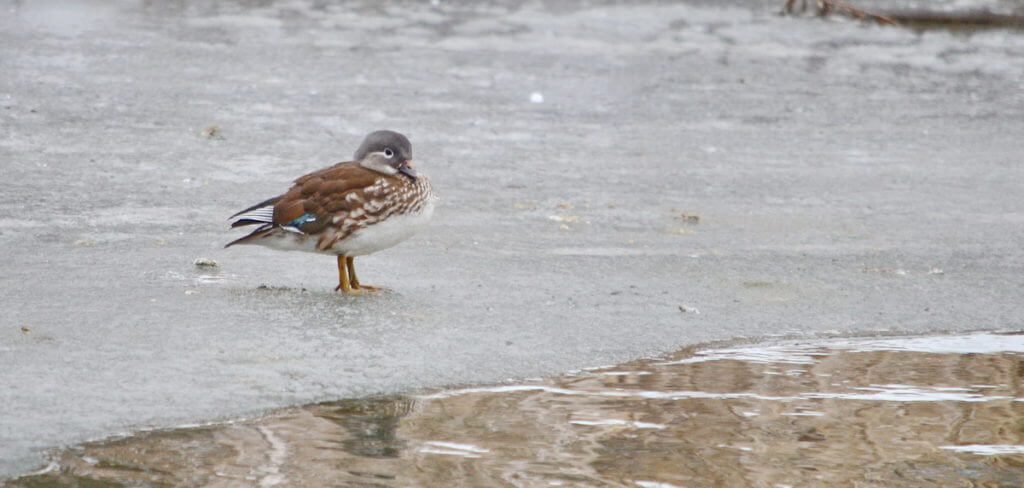
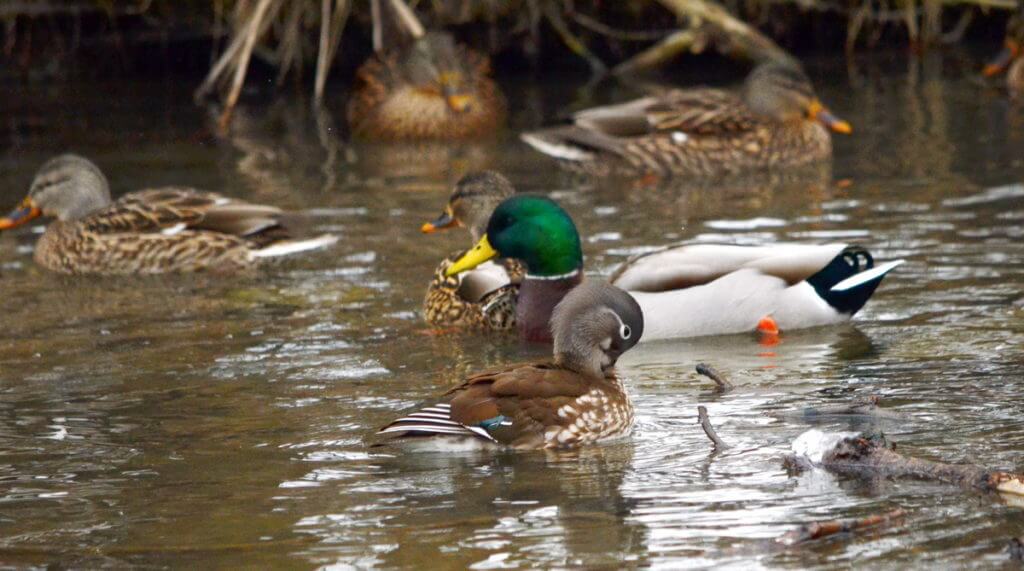
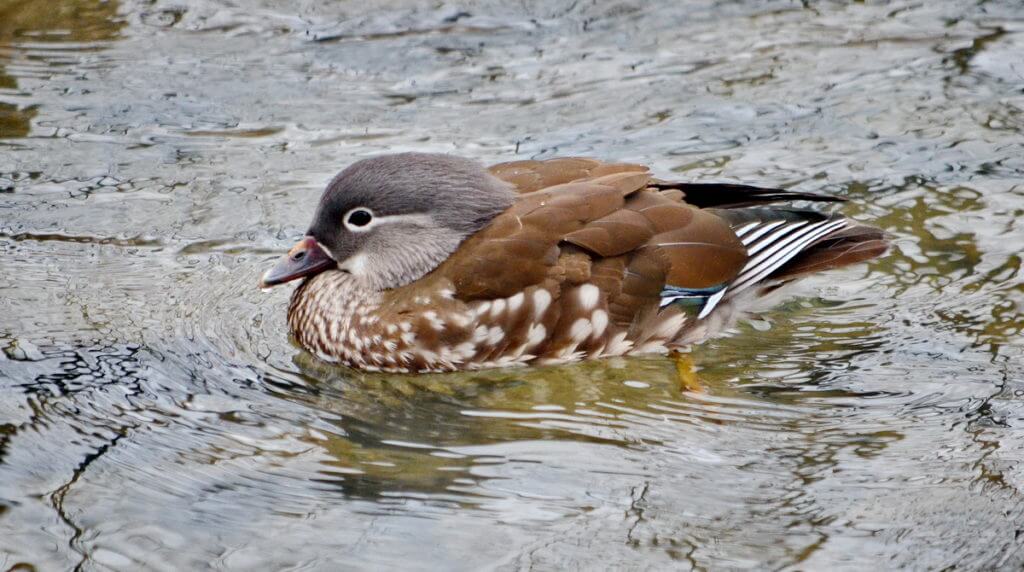

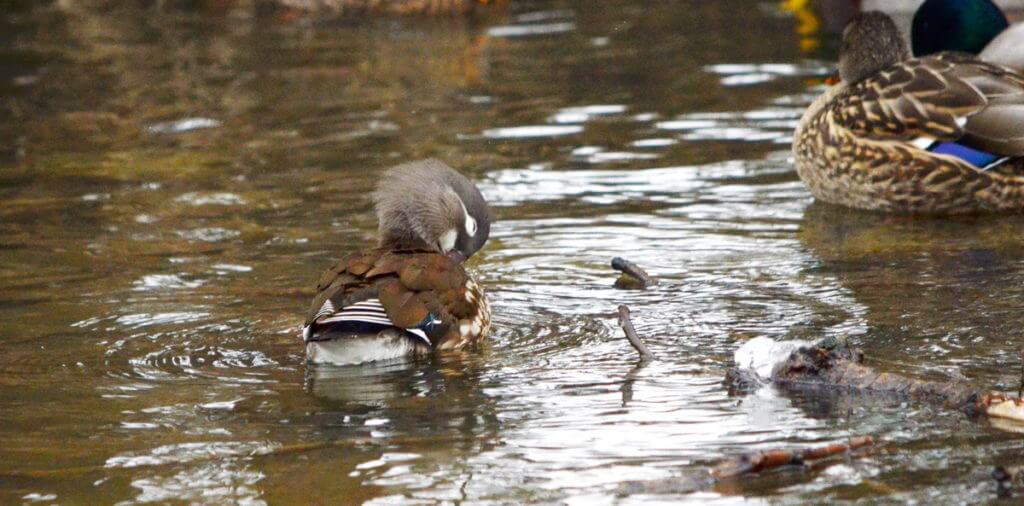
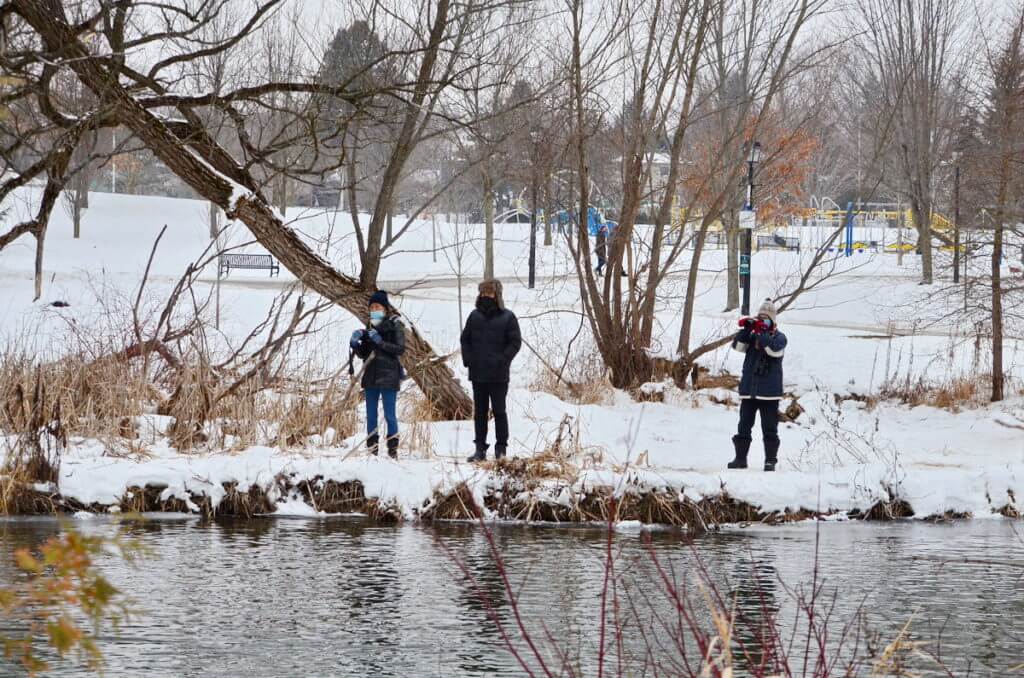
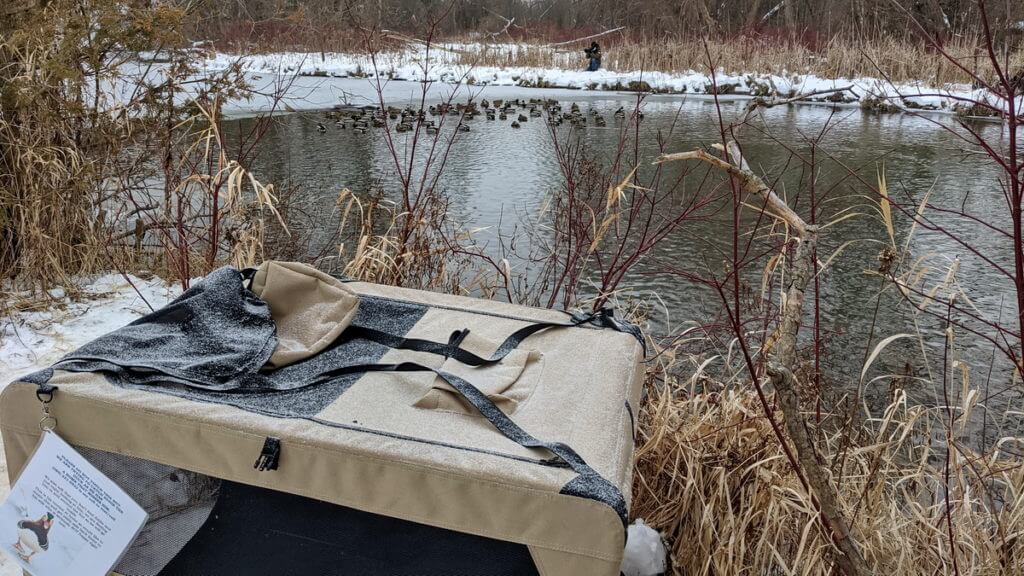
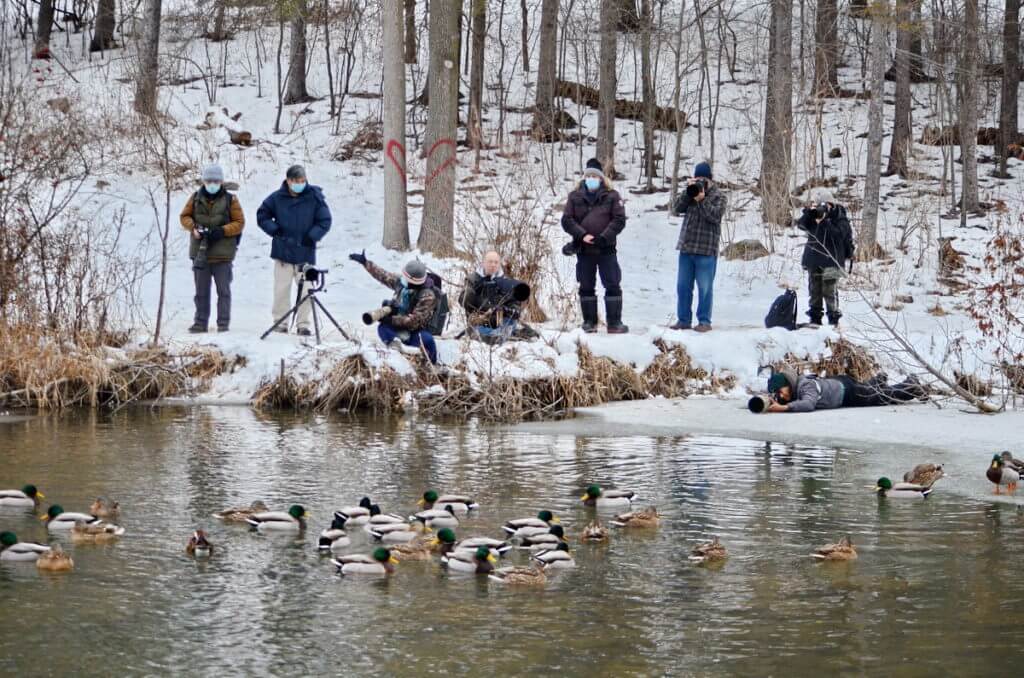
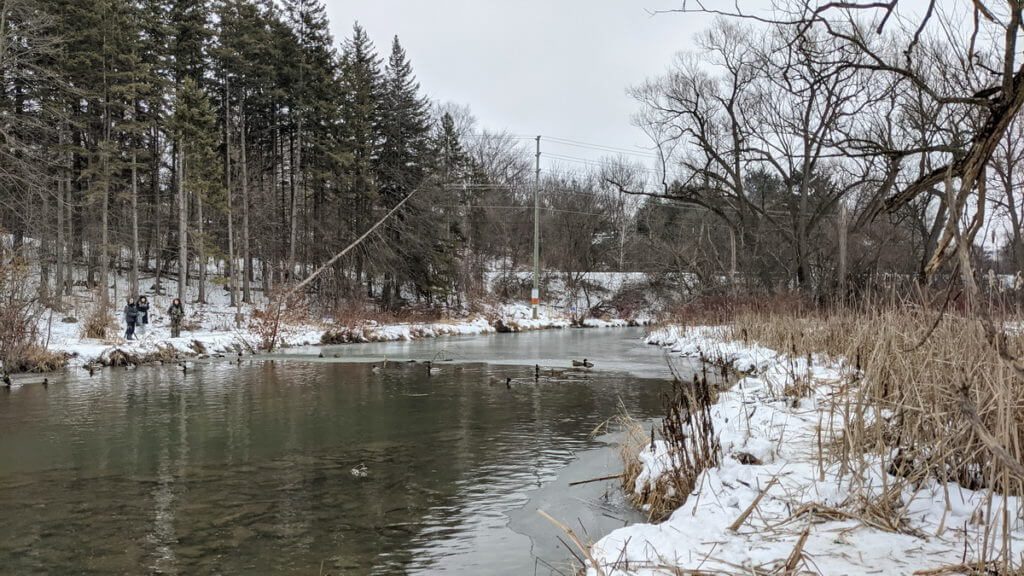
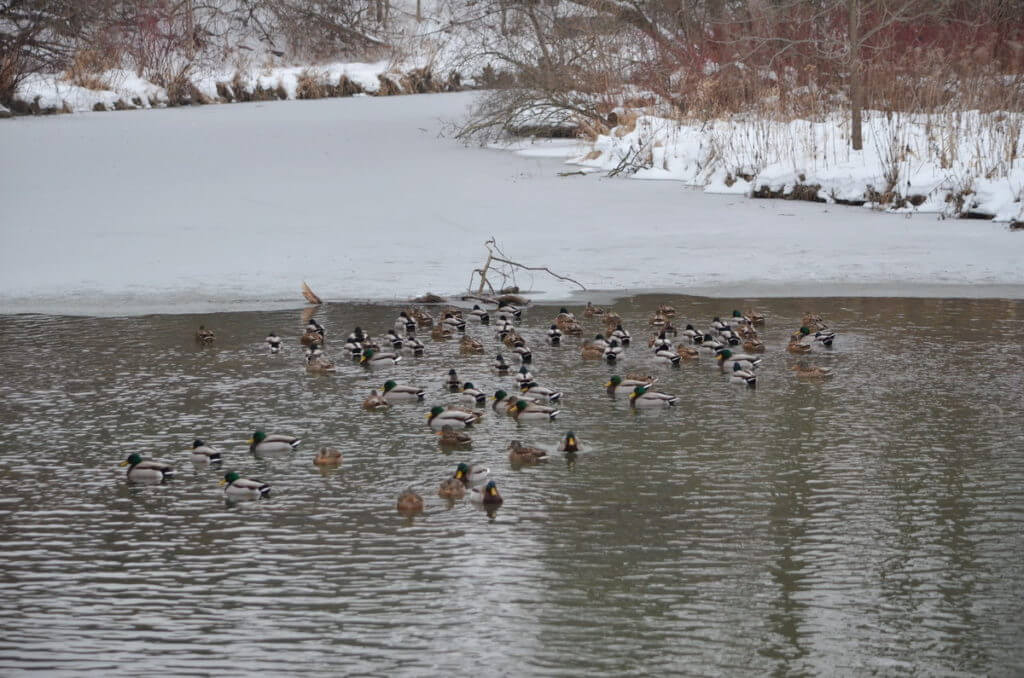
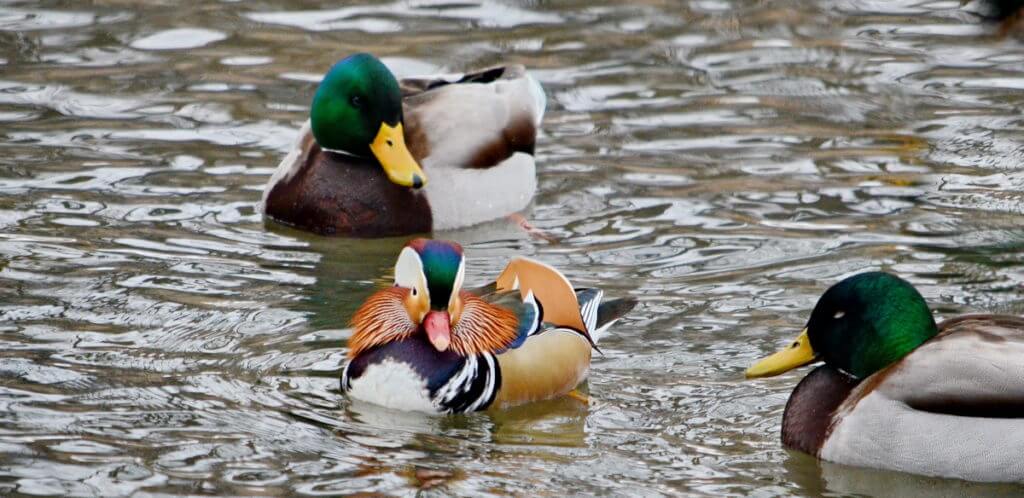
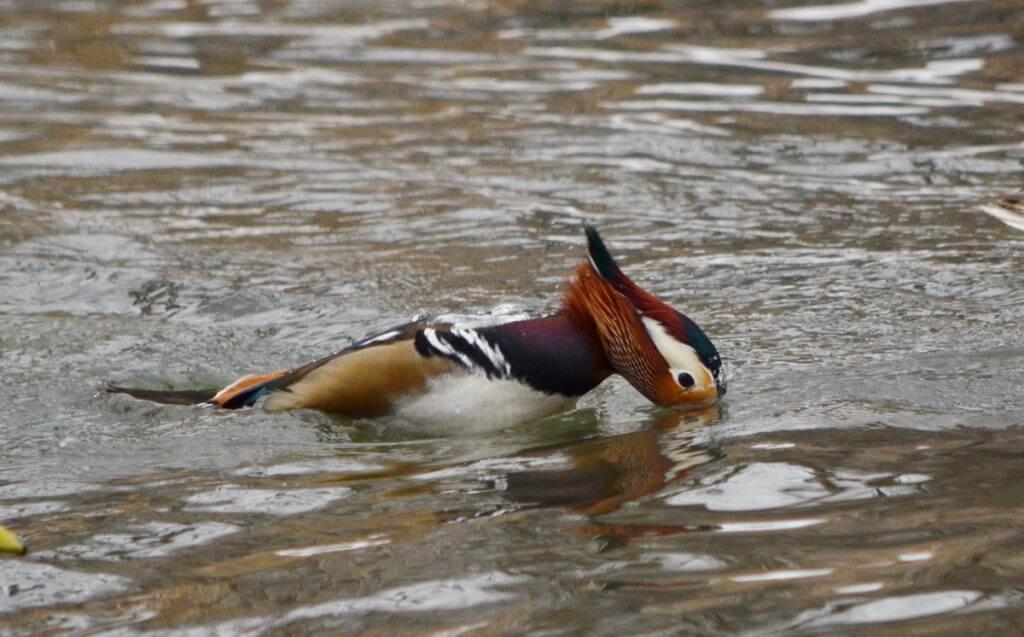
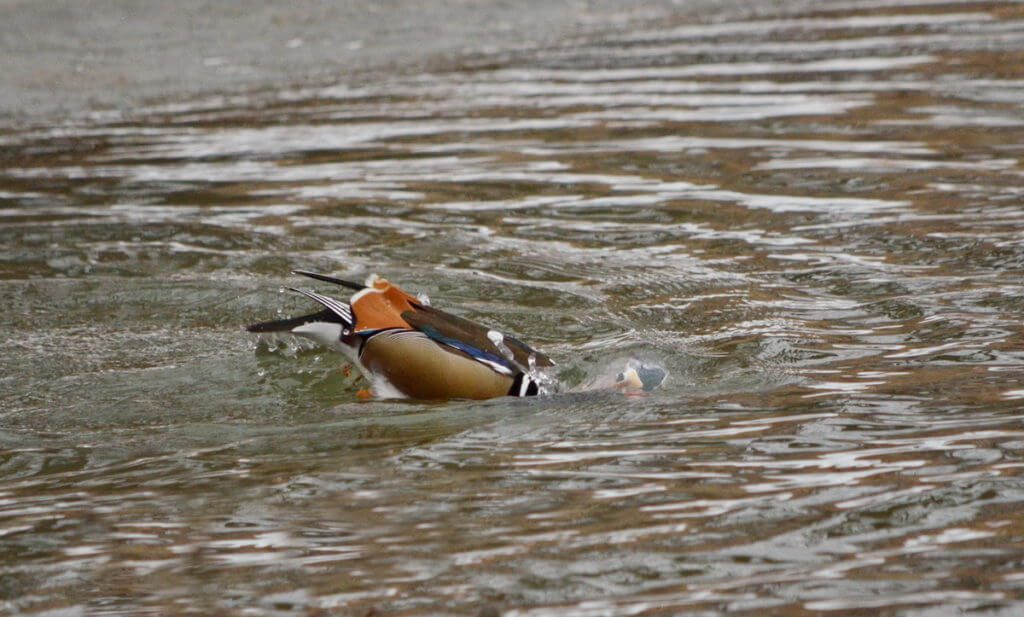
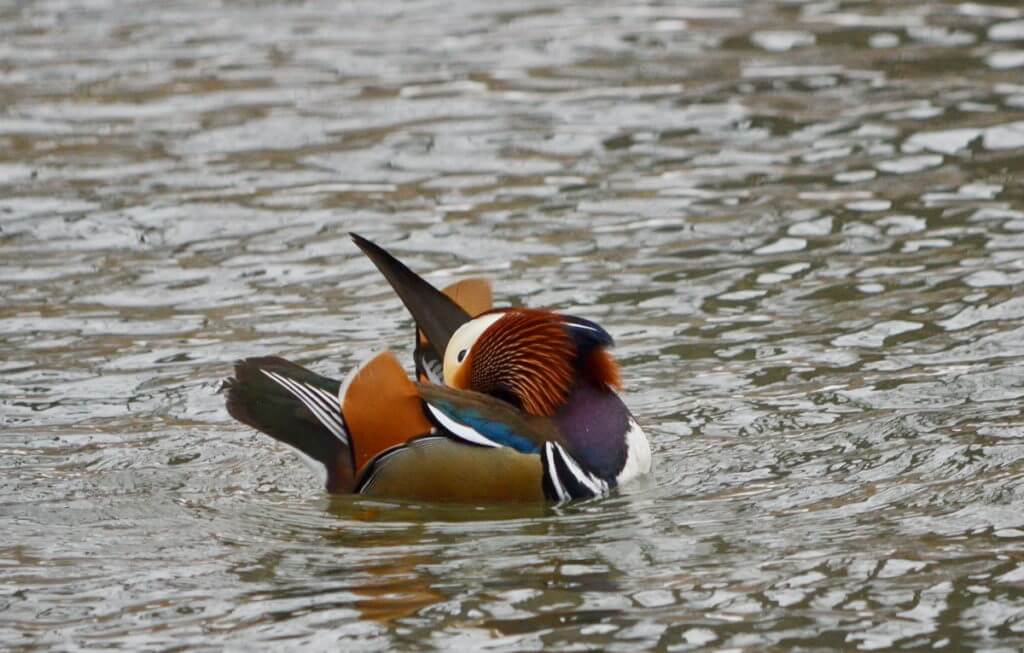
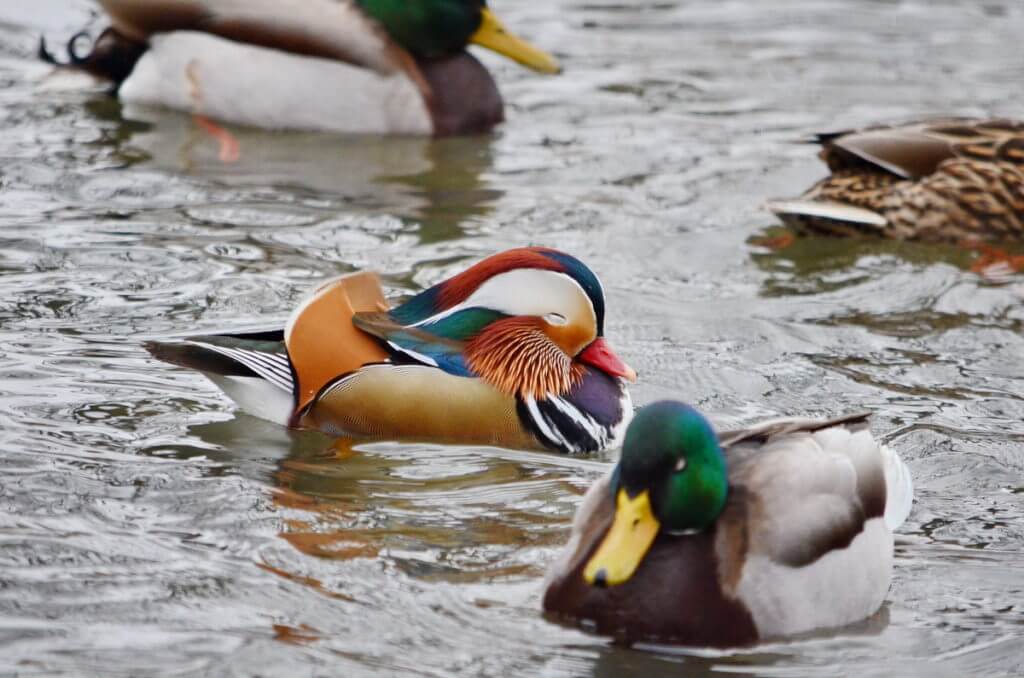

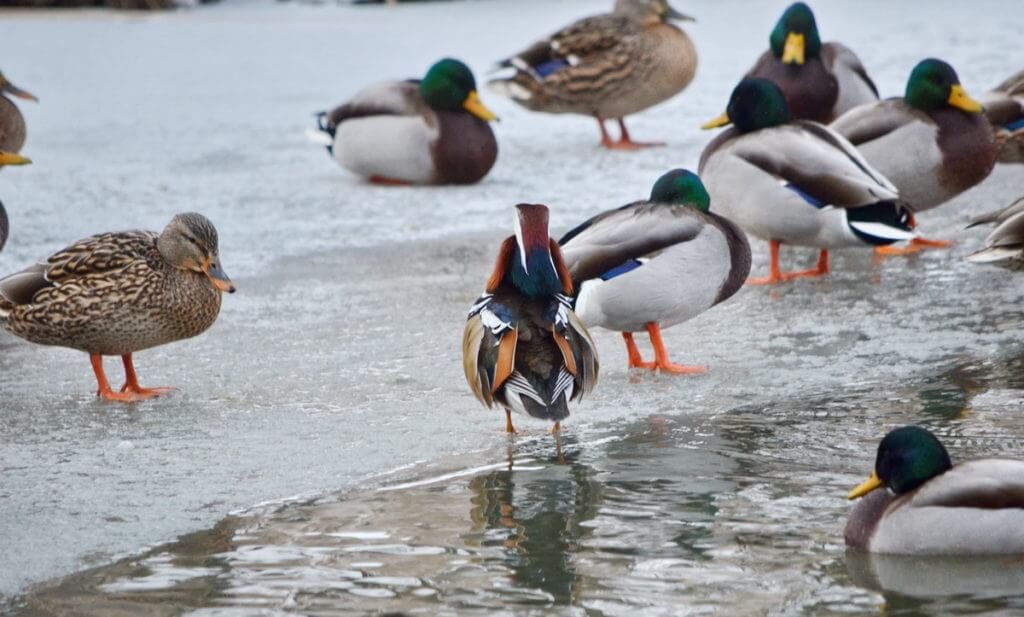
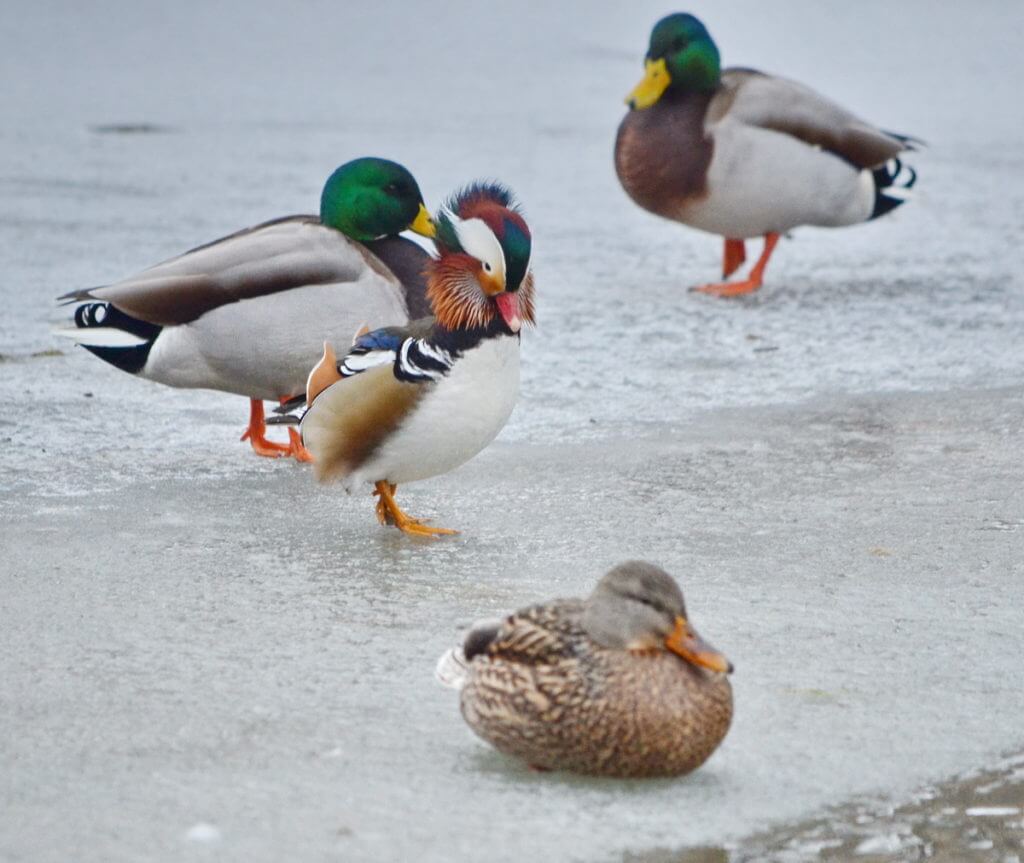
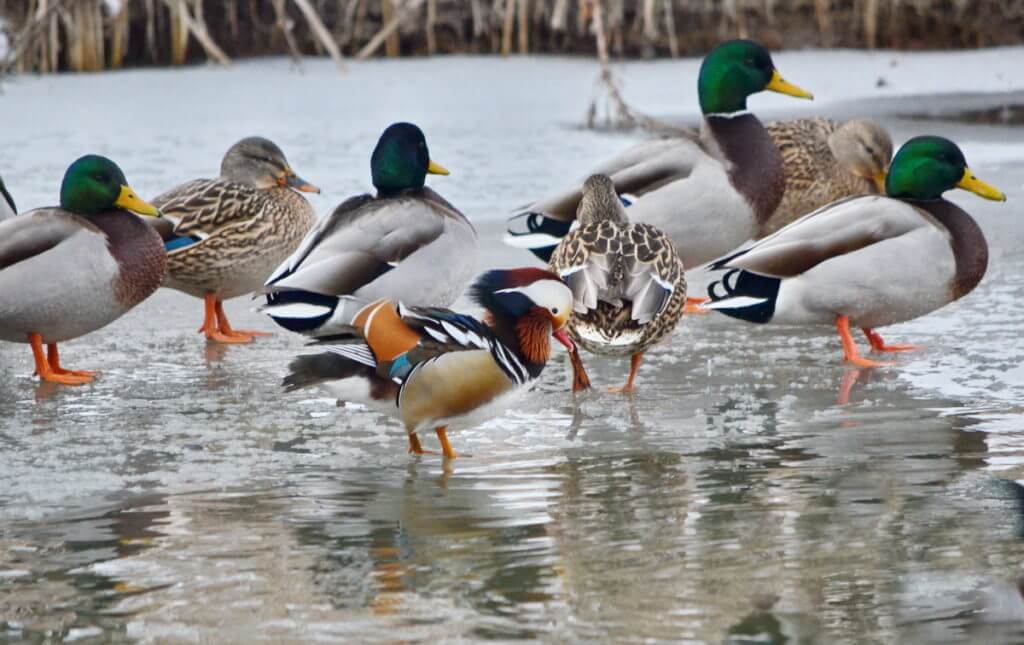
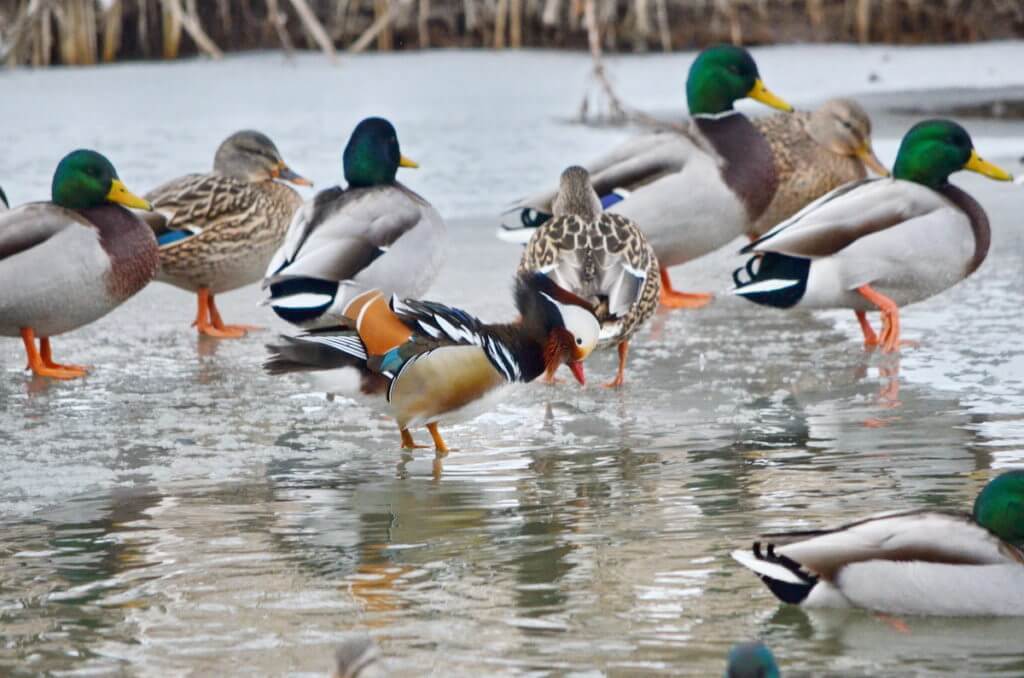
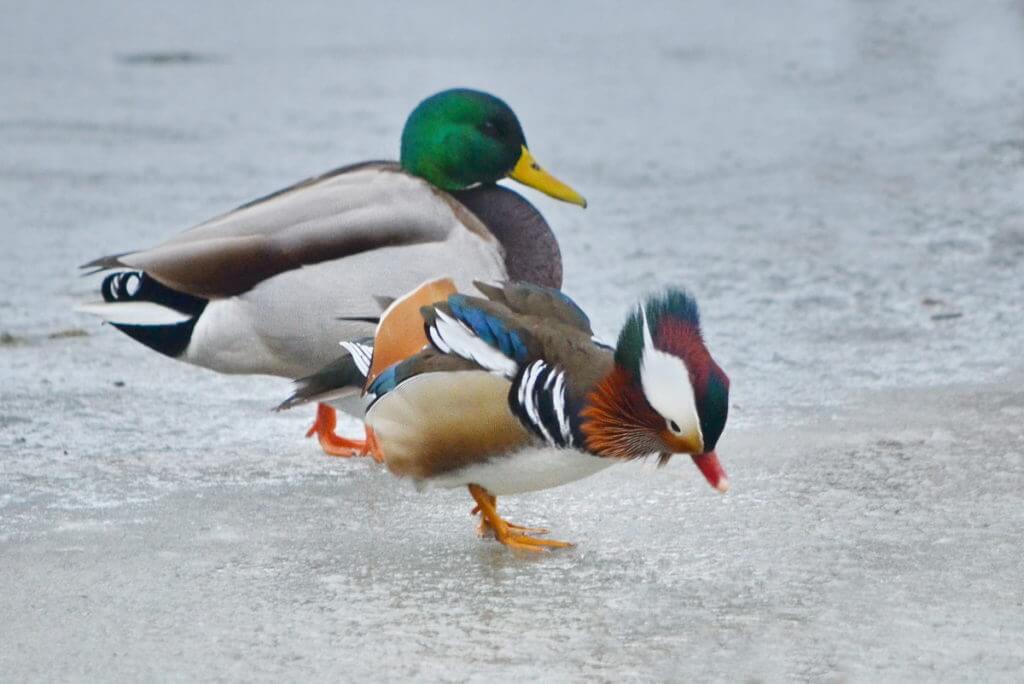

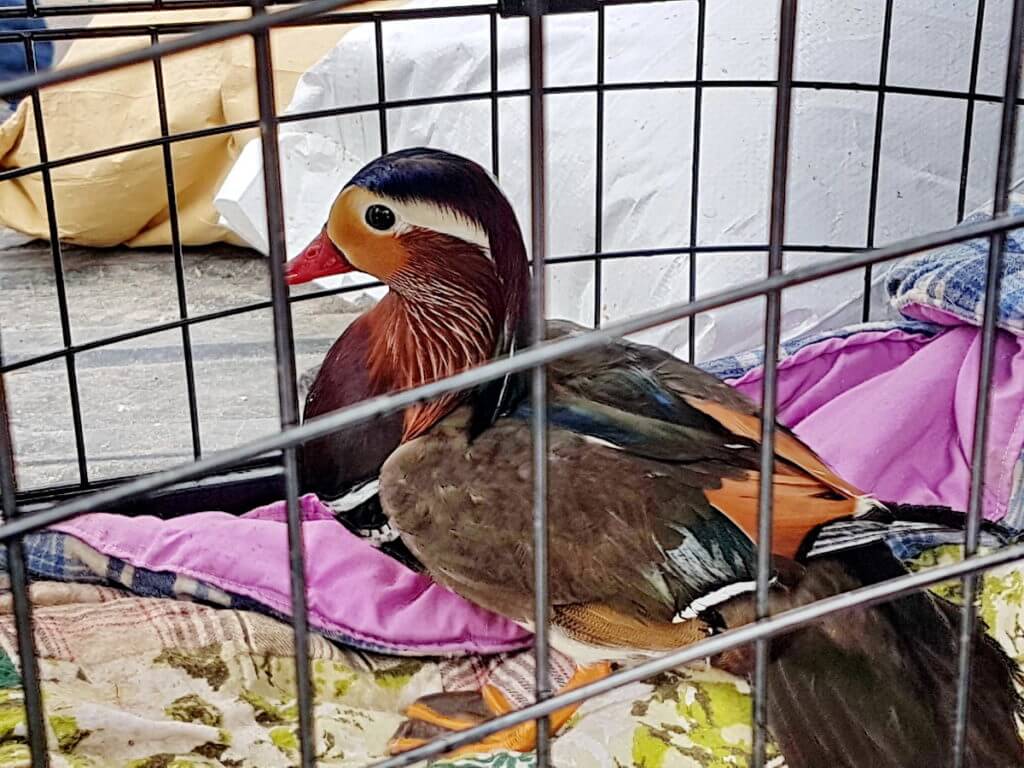
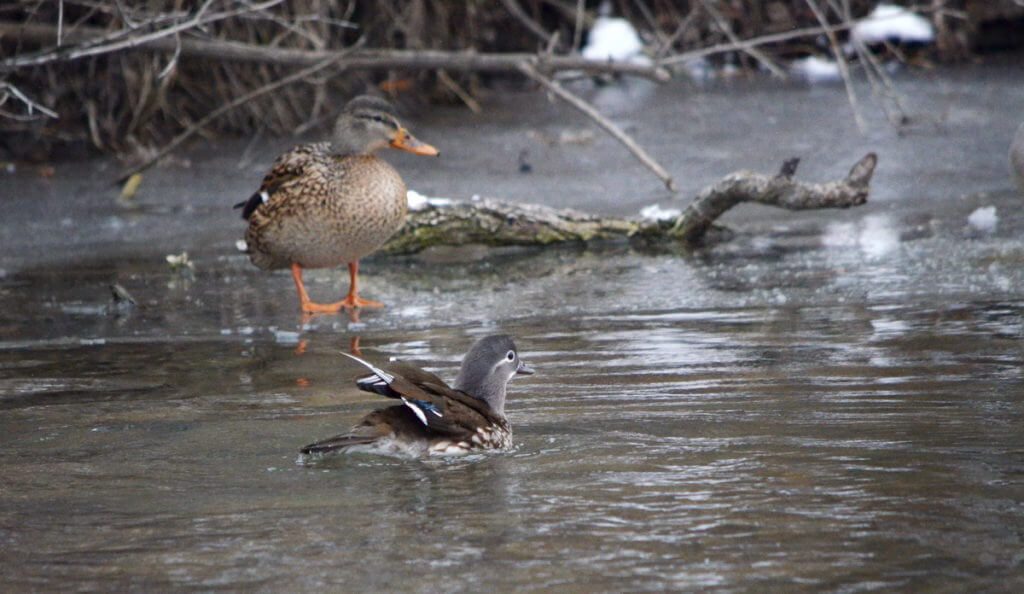
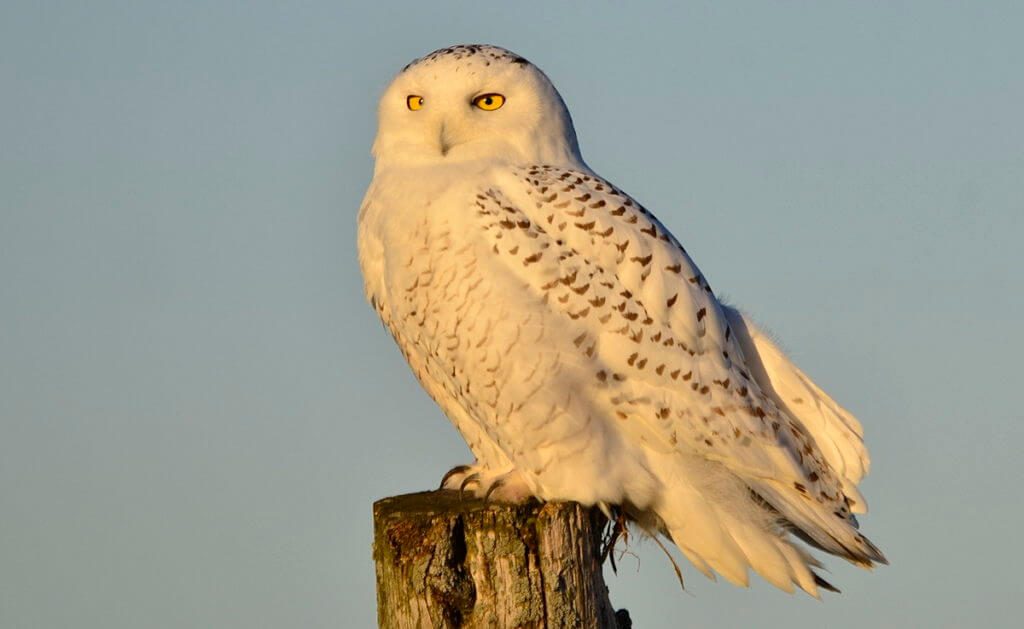
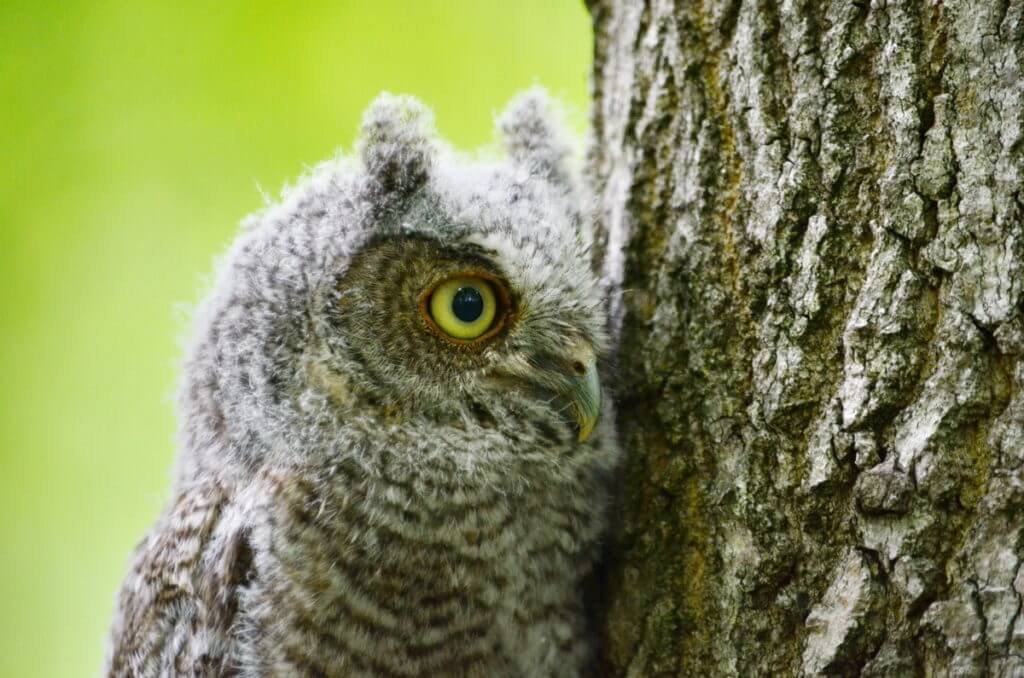
I want to convey the sheer delight I had in reading your story about Eddie.
It’s so much fun to see your beautiful photos and to learn, as I always do, about the wildlife you encounter, thanks to the extra research you do. Thank you!
Thank you for such a lovely comment, Debra. It gives us great pleasure to know that we enlighten our readers and that they appreciate our photos.